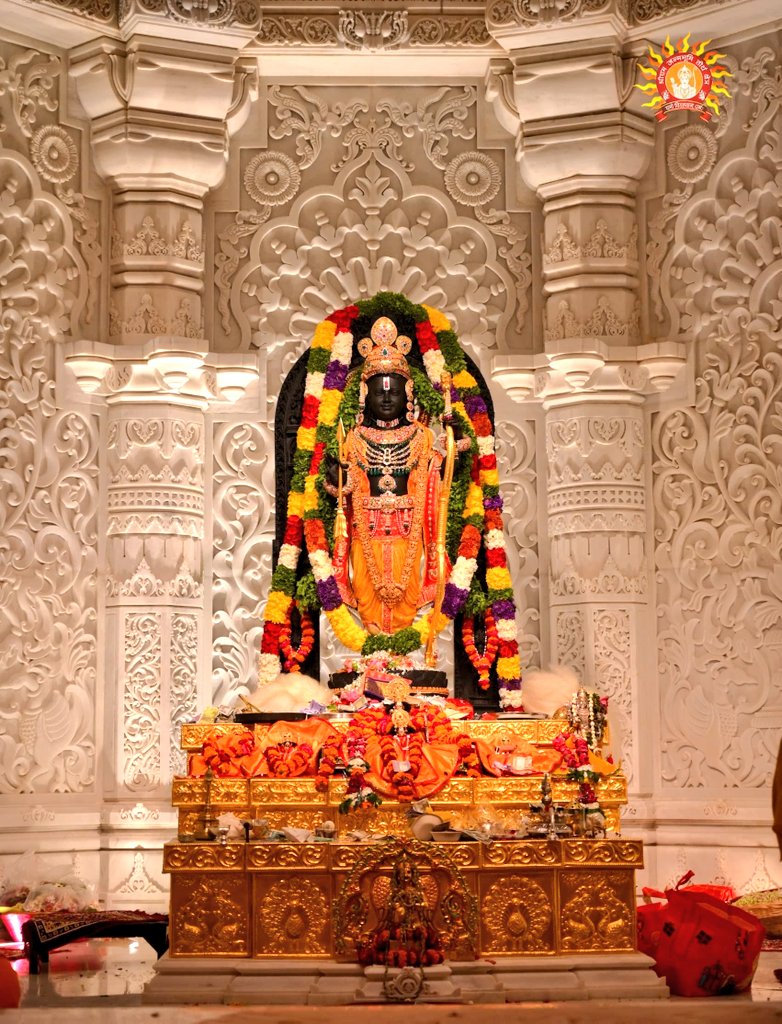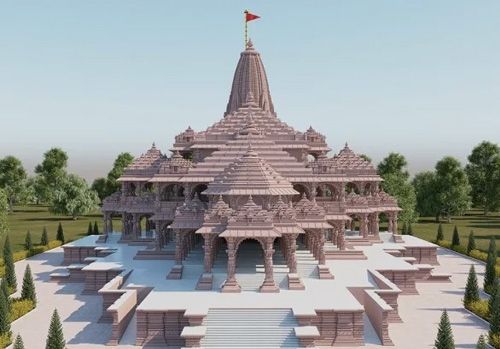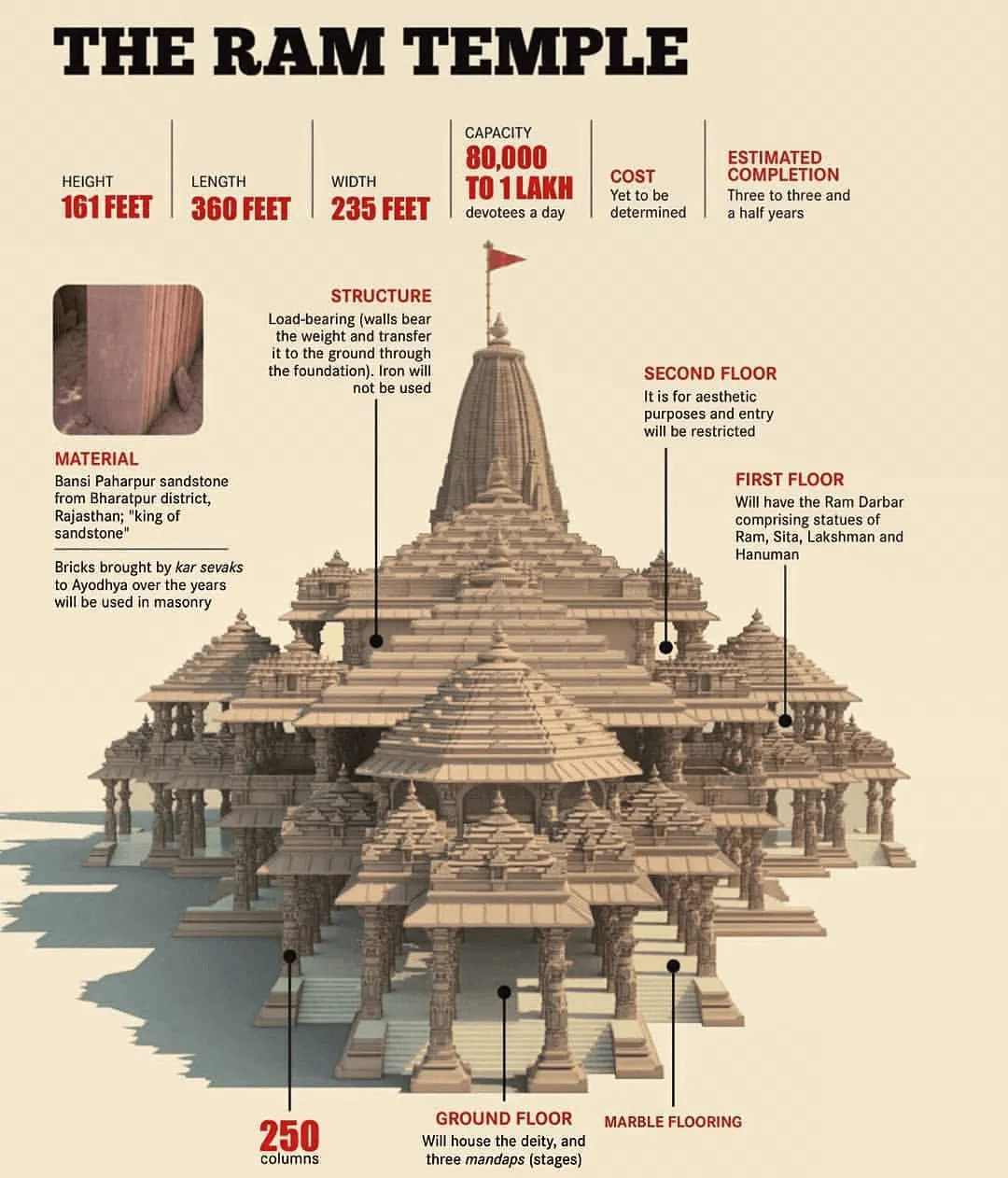Table of Contents
Ram Mandir Ayodhya: The Ultimate Guide to Its History, Significance, and Visitor Experience

The Deep-Rooted History of Ram Mandir Ayodhya
From Ancient Times to Mughal Era
Historical texts like the Skanda Purana and Valmiki Ramayana mention Ayodhya as a thriving spiritual and political center. However, in 1528, the site’s narrative shifted when Mir Baqi, a commander under Mughal emperor Babur, constructed the Babri Masjid here. Many Hindus claimed this mosque stood atop a razed Rama temple, igniting a centuries-long dispute over ownership.
The Modern Struggle and Resolution
Astonishing Facts About Ram Mandir Ayodhya

The Ram Mandir Ayodhya is a marvel of faith and engineering. Here are some incredible details that set it apart:
- Architectural Mastery: Built in the Nagara style of North Indian temple architecture, it features a 161-foot shikhara, 392 pillars, and 12 ornate gates across its octagonal garbgriha (sanctum sanctorum).
- Sustainable Construction: No iron or steel is used; instead, it’s crafted with Bansi Paharpur pink sandstone from Rajasthan and copper plates, ensuring durability for 2,500 years.
- Surya Tilak Phenomenon: On Ram Navami, a sophisticated lens system directs sunlight onto Ram Lalla’s forehead for 6 minutes—an engineering wonder symbolizing divine blessings.
- Time Capsule: A copper capsule buried 2,000 feet underground holds records of the temple’s history, Rama’s legacy, and Ayodhya’s significance for future generations.
- Seismic Resilience: Designed by IIT engineers, it can withstand earthquakes up to magnitude 8.
- Massive Footfall: Since its opening, over 13 crore devotees have visited by September 2024, with daily numbers averaging 1-1.5 lakh.
The temple’s sanctum houses a 51-inch idol of Ram Lalla, carved from black stone by sculptor Arun Yogiraj, depicting Rama as a five-year-old child with a bow and arrow—a sight that leaves visitors spellbound.
Why You Should Visit Ram Mandir Ayodhya
Spiritual Significance
As the birthplace of Lord Rama, the temple radiates divine energy. Devotees believe that offering prayers here cleanses the soul and fulfills heartfelt wishes, making it a pinnacle of spiritual fulfillment.
Historical Importance
Visiting Ram Janmabhoomi lets you stand where a 500-year saga of faith and perseverance unfolded. It’s a living chapter of India’s history, blending ancient mythology with modern unity.
Cultural Extravaganza
The temple showcases India’s architectural heritage, with intricate carvings and a design rooted in Vedic principles. Festivals like Ram Navami and Diwali transform Ayodhya into a vibrant celebration of lights, music, and devotion.
Economic and Social Impact
Ayodhya’s transformation into a spiritual tourism hub has revitalized the region, creating jobs and fostering local crafts. Your visit supports this thriving ecosystem.
Dimensions Details of Ram Mandir Ayodhya

The Ram Mandir Ayodhya is a masterpiece! Here’s all about its amazing design:
- Big Space: It covers 2.7 acres of land.
- Built Area: The temple has a built-up area of 57,400 square feet.
- Size: It’s 360 feet long and 235 feet wide.
- Height: The temple stands 161 feet tall, including its peak.
- Floors: It has 3 floors, each 20 feet high.
- Pillars: There are 160 columns on the ground floor, 132 on the first floor, and 74 on the second floor.
- Peaks and Pavilions: It has 5 beautiful peaks and pavilions.
- Gates: The temple has 12 gates for entry.
This design makes Ram Mandir Ayodhya not just a place to pray but also a wonder to see!
Architecture Details of Ram Mandir Ayodhya
The temple’s look is amazing and full of meaning:
- Style: Built in the traditional Nagara style, an old Indian design.
- Five Halls: It has Nritya Mandap (dance hall), Rang Mandap (color hall), Sabha Mandap (meeting hall), Prathana Mandap (prayer hall), and Kirtan Mandap (singing hall).
- Main Gate: The Singh Dwar on the east side has 32 stairs to climb.
- Holy Rooms: The Garbhagriha has the child form of Lord Rama (Shri Ram Lalla), and the first floor has a Shri Ram Darbar.
- Corner Temples: Four small temples for Shiv, Bhagwati, Ganesh, and Surya are at the corners.
- Other Temples: Maa Annapurna temple is in the north, and Hanuman temple is in the south.
- Carvings: Pillars and walls show beautiful carvings of Hindu gods and goddesses.
- Wall Around: The Parkota wall is 732 meters long and 14 feet wide.
- Kuber Tila: In the southwest, there’s an old Shiv temple and a Jatayu statue.
- Planned Temples: Temples for Maharshi Valmiki, Vasishtha, Vishwamitra, Agastya, Nishad Raj, Mata Shabri, Devi Ahilya, and more are coming in the complex.
Materials Used in Construction
The temple uses special materials to last long:
- Traditional Way: It follows old building methods with no iron or steel (to avoid rust and short life).
- Main Stone: Bansi Paharpur Pink Sandstone from Rajasthan’s Bharatpur is used for most of the temple.
- Strong Base: Granite stones make the plinth strong and long-lasting.
- Decorations: White Makrana marble and colored marble are used for pretty inlay work.
- Foundation: A thick roller-compacted concrete (RCC) layer looks like artificial rock.
- Special Bricks: Ram Shilas (bricks with “Shri Ram” written) are part of it.
- Idol: Sculptor Arun Yogiraj made the Balak Ram idol from black granite from Mysuru, Karnataka.
Properties of Materials Used
The materials are strong and beautiful:
- Sandstone: A rock made of sand grains, it can be any color due to minerals. It’s strong and pretty, used for years. Found in Rajasthan, Andhra Pradesh, and more states.
- Granite: A hard rock from cooled magma, rated 6-7 on the Mohs scale. It doesn’t absorb water, resists acid, and comes in many colors. Found in Odisha, Tamil Nadu, and other states.
- Makrana Marble: A shiny rock from carbonate minerals, used in the Taj Mahal and other famous places. Only found in Makrana, Rajasthan.
Surya Tilak
A special feature of Ram Mandir Ayodhya:
- Sunlight Gift: On Ram Navami, sunlight forms a “tilak” on Balak Ram’s forehead for a few minutes.
- Made By: The Central Building Research Institute (CBRI) under CSIR created it.
- Materials: Made of brass, no battery, iron, or steel—runs on solar power.
- How It Works: High-quality mirrors and lenses guide sunlight to the idol.
Ram Mandir Ayodhya Timings (April 2025)
Planning your visit? Here are the updated Ram Mandir Ayodhya timings:
- Darshan Hours:
- Morning: 7:00 AM – 11:30 AM
- Evening: 2:00 PM – 7:00 PM
- Festivals: Extended to 6:00 AM – 10:00 PM
- Aarti Timings:
- Mangala Aarti: 4:00 AM
- Shringar Aarti: 6:15 AM
- Bhog Aarti: 12:00 PM
- Sandhya Aarti: 7:00 PM
- Shayan Aarti: 10:00 PM
Note: Mangala and Shringar Aarti require pre-booked passes due to limited slots.
How to Book Darshan and Aarti Passes
Online Booking
- Visit srjbtkshetra.org.
- Register with your mobile number (OTP verification).
- Select “Darshan” or “Aarti,” choose a date and time, and enter details.
- Download the free e-pass with a QR code.
Offline Booking
Head to the temple’s camp office near the entrance. Slots are limited, so arrive early with a valid ID (Aadhar, Voter ID, etc.).
Important Guidelines
- Entry is free for all darshan.
- No VIP passes exist—beware of scams.
- Deposit phones, bags, and footwear at designated counters before entering.
Ram Mandir Ayodhya Live Darshan
Can’t make it to Ayodhya? Experience Ram Mandir live darshan from home:
- Official Channels: The Shri Ram Janmabhoomi Teerth Kshetra Trust streams aarti on its YouTube channel and website during major events.
- Virtual Tour: Visit digitalrammandir.com for a 3D experience of the temple.
- Television: Doordarshan and other channels broadcast live during festivals like Ram Navami.
How to Reach Ram Mandir Ayodhya
Ayodhya is well-connected:
- By Air: Maharishi Valmiki International Airport, Ayodhya (11 km away), with flights from Delhi, Mumbai, and Lucknow.
- By Train: Ayodhya Junction (1 km) links to major cities.
- By Road: NH27 connects Ayodhya to Lucknow (135 km) and Varanasi (200 km). Buses and taxis are plentiful.
Best Time to Visit Ram Mandir Ayodhya
Nearby Attractions in Ayodhya
Enhance your trip with these spots:
- Hanuman Garhi: A hilltop shrine dedicated to Lord Hanuman, Rama’s loyal devotee.
- Kanak Bhavan: A golden palace gifted to Sita, adorned with stunning artwork.
- Saryu River Ghats: Perfect for a peaceful boat ride or evening aarti.
FAQs About Ram Mandir Ayodhya
1. Is there an entry fee for Ram Mandir Ayodhya?
No, darshan and aarti are free, though booking is required.
2. Can I visit Ram Mandir without booking?
Yes, for general darshan, but aarti requires a pass.
3. What is the significance of the Surya Tilak?
It’s a rare event where sunlight blesses Ram Lalla’s idol on Ram Navami, symbolizing divine favor.
4. How old is the Ram Mandir Ayodhya?
The current structure was completed in 2024, but its spiritual legacy dates back thousands of years.
5. Are children allowed inside?
Yes, but strollers and large bags aren’t permitted.
Conclusion: A Journey Worth Taking
The Ram Mandir Ayodhya is a divine blend of history, faith, and architectural brilliance. Whether you seek blessings, explore its legacy, or join the Ram Mandir live darshan, this temple promises an unforgettable experience. Plan your visit today, and share your story with us at www.templestory.in. Jai Shri Ram!
